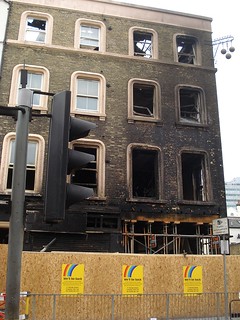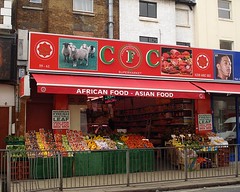60–62 London Road is currently occupied by one of the area’s newer businesses — a nail salon called White Sands, which opened in March 2014.
1860s: Construction of the building
This large four-story building is one of the more imposing frontages on London Road. Situated on the corner of Oakfield Road, it was constructed in the mid-1860s on land that had previously been part of the Oakfield Estate.[1]
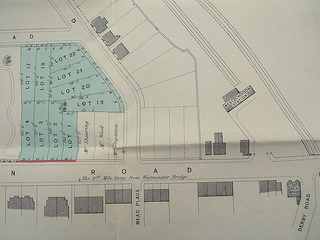
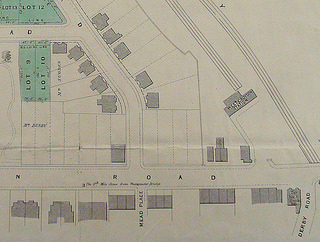
Before the mid-1860s, much of the east side of London Road between West Croydon Station and St James’s Road was occupied by two large houses and their accompanying grounds and outbuildings: Oakfield Lodge to the south, and Broad Green Place to the north. The estate surrounding Oakfield Lodge — Oakfield Estate — was mostly broken up and sold to developers after the death of the owner, Richard Sterry, in February 1865. As part of the development of the land, new side roads were constructed, including Oakfield Road.[3]
Oakfield Road was built in 1865,[4] and by October 1866 the plot on the corner of London Road and Oakfield Road was owned by a Mr Stapleton, though not yet built on.[5] The building which later came to have the address of 60–62 London Road was constructed shortly after, in late 1866 or in 1867.[6]
Late 1860s–early 1870s: John Edmund Hastings, pawnbroker and silversmith
The first occupant was a pawnbroker and silversmith named John Edmund Hastings. Born in Norfolk, he was in his late 40s or early 50s when he arrived on London Road. By 1871 he employed at least four assistant pawnbrokers, and he may also have had an upholstery business a few doors further south.[7]
Early 1870s: C B Vaughan, pawnbroker and jeweller
John Hastings was replaced in the early 1870s by another pawnbroker and jeweller named C B Vaughan.[8] However, according to Aileen Turner’s History of Broad Green, Mr Vaughan was involved in a lawsuit which led to his vacating the premises shortly after.[9]
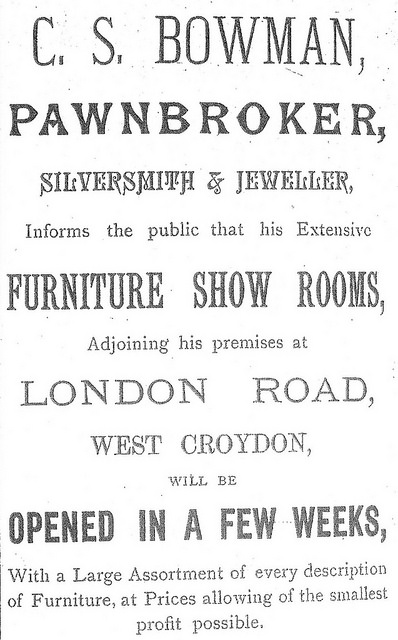
1870s–1880s: Charles Samuel Bowman, pawnbroker, jeweller, and house furnisher
The next pawnbroker to set up shop on the corner of Oakfield Road was to have a much longer-lasting influence. Like John Hastings, Charles Samuel Bowman was not a native Croydonian, but was born around 1840 in Cambridgeshire. He moved to London before his 21st birthday and started working his way up in the pawnbroking trade; by 1861 he was was working as a pawnbroker’s shopman in Greenwich, and by 1871 he and his older brother Richard were trading as pawnbrokers at 70 Goswell Street in Clerkenwell.[10] By 1876, he had moved to Croydon and was trading from London Road.[11]
Initially operating only as a pawnbroker and jeweller, in 1880 Charles Bowman expanded his business to also encompass furniture.[12] By 1881 he was trading across four shopfronts, advertising himself as a “complete house furnisher, upholsterer, and cabinet manufacturer”, and claiming to have “the largest stock of carpets in Croydon, at the lowest possible prices.”[13]
He may in fact have expanded his premises at the same time as he expanded his stock. Although today the upper floors of 60–66 London Road look relatively uniform from the front, differences in the roofs and at the back suggest it’s not impossible that 60–62 was built first and later extended by the addition of 64–66.[14]
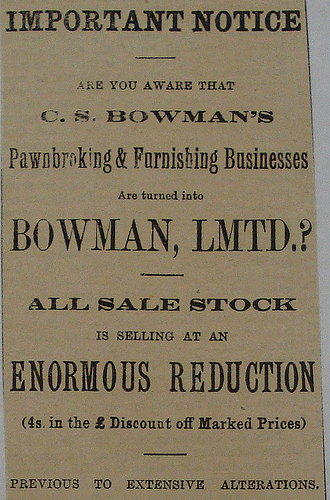
1890s–1980s: Bowman Ltd
By 1889 the premises were known as Bowman’s buildings,[15] emphasising the extent to which this business was known locally. However, in early 1892 Charles was declared bankrupt, and by January 1893 the business previously known as C S Bowman had become Bowman Limited.[16]
Charles himself appears to have blamed his financial difficulties entirely on his attempts to help out his less-successful relatives. An article on page 8 of the Surrey Mirror of 11 June 1892, reporting on the “first meeting of creditors under the failure of Charles Samuel Bowman of London-road, Croydon, pawnbroker and jeweller and general salesman”, notes that “The debtor attributes his insolvency entirely to losses in respect of accommodation bills signed on behalf of, and money lent to, his two brothers, Richard and Reginald Bowman (who are also before the Court), during the last ten or twelve years.”[17] Another Surrey Mirror article states that Charles applied to the London Bankruptcy Court for a discharge in August of the same year, but “without immediate success, the order being suspended for two and a half years.” [18]
Charles Bowman died on 3 March 1906, at the age of 65,[19] but his business lived on. The most obvious immediate change was that the premises were halved in size; numbers 64 and 66 were vacated, and from then on Bowman Ltd traded only from 60–62.[20]
There is conflicting evidence as to when Bowman Ltd finally closed. A front-page Croydon Advertiser article from 16 January 1981 states that “the whole business [...] will close in March or April”, and reports that the manager, Stanley Goodwin, “blamed the shop’s demise on the Government which allows pawnbrokers to charge only 20 per cent interest.” However, Croydon phone books continue to list Bowman Ltd, jewellers, watchmakers, and diamond merchants, well beyond 1981 — in fact, almost up to the present day.[22] Moreover, the Bowman frontage was in place until at least 1992, and possibly as late as 2001.[23]
1989-2011: Albemarle Bond
Albemarle Bond first appeared in West Croydon in 1989, and was initially located just around the corner on Oakfield Road. At that time, the company was known as Albemarle & Bond, though the ampersand was later dropped. By 2008 it had not only moved into the former Bowman’s premises but also replaced the shopfront with one of its own.[24]
Disaster struck on the evening of 8 August 2011 as rioters thronged London Road, smashing windows and looting shops.[25] Several buildings were gutted by fire, including the Albemarle Bond branch at 60–62 London Road.
The damage to the building was extensive, and Albemarle Bond staff initially feared the loss of the gold jewellery they had accepted from customers as security on loans. Stored in five safes in the basement, this jewellery was not only in danger of having melted, but also made an attractive target for criminals. Several attempts were made to break into the building over the next few months, but all were thwarted by the security measures that had been put in place. Eventually, in December 2011, the safes were removed via crane in an operation that involved road closures and armed police officers.[26]
The West Croydon branch of Albemarle Bond reopened at 5 London Road in mid-December 2011, and remains there today.[27]
2014: White Sands
By November 2012 refurbishment was complete and the premises were advertised to let. However, it was not until the end of the following year that shopfitting work began to outfit the ground floor as a nail spa. Signs advertising for staff appeared in January 2014, and White Sands opened on 14 March 2014.[28]
Annette, the owner of White Sands, was originally an accountant, but decided on a career change after being made redundant. She explained to me that following a trip to the USA, she realised there was a gap in the rather polarised nail bar provision in the UK. Her intention was to create something that combined the best features of both types of nail bar — the acrylics, nail art, and reasonable prices offered by the cheaper end of the market, and the peaceful environment, bookable appointments, and welcoming service offered by the more expensive end.
Appointments at White Sands can be booked in person, over the phone, on their website, or via Facebook, using an integrated booking system provided by Phorest salon management software; walk-ins are also catered for. Customers are given “treat cards” to collect points which can be exchanged for free treatments. Complimentary tea, coffee, cupcakes, and wine are on offer too, all aimed at enhancing the relaxed atmosphere.[29]
When I visited in October 2014 for an express manicure (£10) and a spot of nail art (charged depending on time; mine was £5), it became clear that Annette has succeeded in her aim. And she makes a great cup of tea, too!
Thanks to: Annette at White Sands; Brian Mortimer; Jodi Crisp; ppaces; Sarah Creates at Albemarle Bond; the Planning Technical Support Team at Croydon Council; all at the Croydon Local Studies Library; and my beta-readers Flash and Shuri. Census data consulted via Ancestry.co.uk.
Footnotes and references
In previous articles I’ve advanced the possibility that 60–62 London Road was built before 1850 and started its life as William Meredith’s corn and coal store. Identification of buildings on the east side of London Road before 1890 is complicated because none of them had street numbers, but street directories make it clear that William Meredith’s store was between West Croydon Station and Oakfield Lodge (the latter of which was situated on land that later became the General Hospital site). However, the maps included here make it pretty clear that 60–62 was built after the 1866 plan was produced, and William Meredith’s store must therefore have been further south. Moreover, as described in the main article, before Richard Sterry’s death in February 1865, the Oakfield Estate still extended over the land on which number 60–62 was later built.
Oddly, Jesse Ward’s Croydon in the Past, published in 1882, states that in 1851, “The only houses on the right hand side of the London Road, beyond the West Croydon Station, were Oakfield House, Broad Green Place, and one other house near the entrance of St. James's Road. [...] It is rather singular that there was not a place of business on the London Road.” (Note that by “on the London Road” he’s only talking about south of Broad Green; in the next sentence he notes that “We meet a few shops at Broad Green, and then fields up to Thornton Heath Pond, round which were congregated a few houses.”) His comment on there being no “place of business” on London Road at this point is rather strange given that Gray’s 1851 directory lists Meredith’s corn store north of the station.
- The 1866 map is in the collection of loose sales particulars (ref CR2615). The 1867 map is in the maps drawers (map 12 in drawer 39); the textual parts of the relevant sales particulars are in Harold Williams 1867 volume (ref DCLIX).
- Aileen Turner’s History of Broad Green (shelfmark S70 (9) TUR at Croydon Local Studies) gives more details of Richard Sterry’s life and death, including his date of death and the information that much of the estate was “sold to developers who formed Kidderminster/Oakfield and all the little roads between”. The only part of the estate that wasn’t sold off was the house and its immediate surrounds; these were let to a Mr Rickett and later sold to the Croydon Hospital Committee (more information on this can be found in my article on the Croydon General Hospital site).
- The particulars for a sale of building plots on 17 November 1865 describe Oakfield Road as “a new 40-ft. road” (Harold Williams 1865–66 volume, ref DCIX, at Croydon Local Studies).
- The particulars for a sale of “freehold building plots” on 18 October 1866 include a plan which shows “Mr Stapleton” as the current owner of the plot on the corner of London Road and Oakfield Road; see excerpt of this in the main article.
- The particulars for another sale of “freehold building plots” on 24 October 1867 include a plan showing that by that point Mr Stapleton’s plot had been built on.
- John Hastings’ pawnbroking business is listed in Warren’s 1869 and Wilkins’ 1872–3 directories (under the names John Edmund Hastings and J E Hastings, respectively). This side of the road had no street numbers until 1890, but both of these directories locate the business between Oakfield Road and Oakfield Lodge. Wilkins’ 1872–3 in addition lists a J E Hastings, upholsterer, further south at an unnumbered address that could either have been the present number 20 or the building that was demolished around 1899 and replaced by numbers 22 and 24–26. The 1871 census lists John E Hastings, age 53, born in Norfolk, along with his wife Ann, four assistant pawnbrokers aged between 15 and 19, and two servants. He could of course also have employed additional assistants who lived elsewhere.
- C B Vaughan is listed as a pawnbroker and jeweller in Ward’s 1874 directory.
- Aileen Turner’s History of Broad Green states on p507 that C B Vaughan was gone by 1873. This doesn’t quite mesh with his having an entry in Ward’s 1874 directory, information for which would have been gathered in late 1873. Unfortunately Aileen Turner doesn’t cite her source, or any more details.
- The 1861 census lists Chas [Charles] Bowman, age 21, born in “Cambridge”, “Shopman to Pawnbroker”, living in Greenwich in the household of a pawnbroker possibly named Sanders (the handwriting on this census page is hard to decipher). The 1871 census lists Richard and Charles Bowman, aged 33 and 31 respectively, both born in “Cambridge”, pawnbrokers, at 70 Goswell Street in the Parliamentary Borough of Finsbury, along with two pawnbroker’s assistants and a “General (Domestic) Servant”. According to Chapter XII of Volume 46 of the Survey of London (available at British History Online), Goswell Street was the old name for the southern part of today’s Goswell Road.
- Charles Bowman is listed in Ward’s directories from 1876 onwards, as well as Wilkins’ 1876–7, Worth’s 1878, Atwood’s 1878, Purnell’s 1882, and various of Kelly’s directories. His full name is given as Charles Samuel Bowman in Kelly’s 1890 directory.
- An April 1880 advertisement in the Croydon Review (viewed as a clipping in the firms files at Croydon Local Studies) states that furniture showrooms “Adjoining [C S Bowman's] premises at London Road” will open “in a few weeks”.
- The quoted text comes from an advert on pages 16–17 of the October 1881 Croydon Review, viewed on microfilm at Croydon Local Studies Library. The information on his trading across four shopfronts comes from an illustration in the same advert (reproduced in the main article above). In addition, when the east side of London Road received street numbers for the first time in 1890, Charles Bowman was allocated numbers 26–32 (later renumbered to 60–66).
- The October 1867 map reproduced in the main article shows a building on the corner of Oakfield Road with a vacant plot alongside, and I believe this vacant plot is where 64 and 66 were later built. The boundary between the 1867 building and the vacant plot is roughly opposite the third property in from Mead Place; this property is number 59, which today is roughly opposite the boundary between number 60–62 and number 64. Moreover, an advert on pages 16–17 of the October 1881 Croydon Review (viewed on microfilm at Croydon Local Studies Library) states that C S Bowman was then in possession of “new, extensive, and well-stocked warehouses [...] well worth a visit [...at...] London Road, West Croydon (corner of Oakfield Road)”, and the April 1880 advert reproduced in the main article states that Bowman’s “Extensive Furniture Show Rooms” were “Adjoining his premises at London Road”. The wording in these adverts strongly implies that there’s a new building next to the older one.
- Kelly’s directories for 1889, 1890, and 1891 list Charles Samuel Bowman, pawnbroker, with “(Bowman’s buildings)” as a note against the entry.
- Charles Bowman’s bankruptcy is reported on page 657 of the 20 May 1892 Edinburgh Gazette (PDF) in a section titled “Bankrupts from the London Gazette” — I haven’t been able to find the original report in the London Gazette itself. See the 1893 Croydon Guardian advert in the main article for evidence on the change to a limited company.
- Surrey Mirror, 11 June 1892, p8, viewed online at the British Newspaper Archive (requires subscription).
- Surrey Mirror, 13 August 1892, p8, viewed online at the British Newspaper Archive (requires subscription). This article also goes on to note that “Mr. Bowman ascribed his financial troubles to his relations whom he had accommodated with his autograph.”
- The FreeBMD Death Index 1837–1915 records the death of Charles Samuel Bowman, age 65, in Croydon, in the first quarter of 1906. The GOV.UK “Find a will” search further reveals that his exact date of death was 3 March (bottom of page).
- Ward’s directories list Bowman Ltd at 26–32 London Road up to and including 1906, and 26–28 thereafter. Note that 26–32 were renumbered to 60–64 in 1927. Following Bowman’s retrenchment, number 30 (i.e. modern 64) was unoccupied for a brief time, and then the Croydon Co-operative Society moved in. Number 32 (i.e. modern 66) remained unoccupied for several years.
- Brian Mortimer, who took this photograph, tells me that 1992 is the earliest it could possibly have been taken: “The negative for this photo was not in my 1991 archive. i found it in the non-archived lot from 1992-95 and i have spotted that there are Christmas decorations in the windows of the shop. This means that it was taken either in December 1992 or January 1993 as it wasn't taken at the same time in 1992 when ITV were filming for The Bill at the crossing in front of the restaurant. The details on the buildings in the The Bill photos are exactly the same as the shop photo. Also, to confirm this, the negative for this photo was from the bulk roll i had when i started processing my own films again in 1992 and not from the Agfa rolls i used up to that time.” (via email, 10 November 2014). The The Bill photos Brian refers to are filming bill 1 and filming bill 2.
- Bowman Ltd appears at 60 London Road in Croydon phone books up to and including 2009–2010. I have no explanation for this. A notice on page 2118 of the 8 February 1991 London Gazette states that a petition to wind up “Chrispawn Limited (t/a [trading as] Bowmans)” was to be heard at Croydon County Court on 8 March of that year, which suggests the possibility that Bowman Ltd was resurrected — at least in name — after its original closure, though I haven’t found any further documentation of Chrispawn.
- See Brian Mortimer’s photo in the main article (and the associated footnote) for evidence as to Bowman’s shopfront persisting to 1992 — though note that the “Ltd” has been painted out on the sign. Regarding the possibility of it still being there in 2001, a planning application granted on July 2001 (ref 01-1489-P, viewed on microfiche at Croydon Council offices) includes an existing front elevation plan with Bowman signage and a proposed front elevation plan with Albemarle & Bond signage, suggesting that the shopfront was not replaced until that date.
- Croydon phone books lists Albemarle & Bond at 1A Oakfield Road from 1990 onwards (there doesn’t appear to have been a Croydon phone book published in 1989). According to Sarah Creates of Albemarle Bond, the shopfront at 60–62 London Road definitely had Albemarle Bond signage on it when she started working there in 2008. Sarah also showed me the plaque pictured in the main article, providing evidence that Albemarle Bond initially opened at 1A Oakfield Road in 1989.
- An overview of the August 2011 riots, which began in Tottenham and then spread to other areas of London and England, can be found on Wikipedia.
- Information in this paragraph taken from The Telegraph article and Croydon Guardian article, both from January 2012.
- Opening date of the Albemarle Bond branch at 5 London Road comes from personal observation.
- Information in this paragraph is from personal observation, aside from the White Sands opening date, which comes from a conversation with White Sands’ owner, Annette, on 22 October 2014. See estate agent’s advert from November 2012, photo of shopfitting work from November 2013, and photo of Staff Wanted sign from January 2014.
- Information on White Sands provided by Annette in conversation with the author, 22 October 2014.

